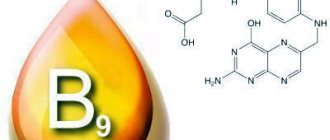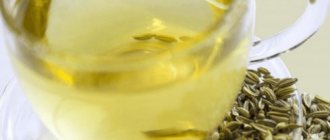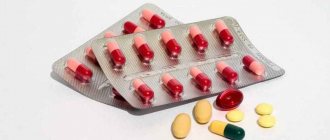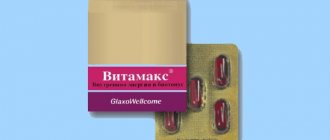Vitamin E is a fat-soluble vitamin. Few people know that it exists in several types of tocopherols and tocotrienols forms (alpha, beta, gamma and delta tocopherol and alpha, beta, gamma and delta tocotrienol). But only one of them all, alpha-tocopherol, is absorbed by the human body.
Vitamin E is one of the most powerful antioxidants. It suppresses the action of free radicals. These compounds are reactive oxygen species that can damage healthy cells. The multifaceted effect of vitamin E supports the health of the cardiovascular system, eyes, nerve fibers, and skin. With its help, a genetic chain is formed. Vitamin E prevents age-related changes, protects against negative external factors, thereby prolonging a person’s youth.
- Vitamin E liquid
- During pregnancy
- Drug interactions
Daily value of vitamin E for women, men and children
| Categories of people | Daily requirement, mg | Natural, ME | Synthetic, ME |
| 0-6 months | 3 | 4,5 | 7 |
| 7-12 months | 4 | 6 | 9 |
| 1-3 years | 6 | 9 | 13,5 |
| 4-8 years | 7 | 10,5 | 15,5 |
| 9-13 years | 11 | 16,5 | 24,5 |
| From 14 years and older | 15 | 22,5 | 33,5 |
| *If breastfeeding | 19 | 28,5 | 42,5 |
*1 IU natural form = 0.67 mg tocopherol.
*1 IU synthetic form = 0.45 mg tocopherol.
The calculation of the individual dosage of tocopherol is related to the person’s weight. So, for adults it is 0.3 mg per 1 kg of body weight. For infants - 0.5 mg per 1 kg of weight. The main condition is that the maximum daily dose of vitamin E should not exceed 1000 mg. The highest dosage is prescribed exclusively by a doctor for a short time. The normal level of vitamin E in the blood ranges from 5 to 18 mcg/ml.
Maximum dose: 1000 mg per day of vitamin E supplementation is the maximum, which should not last long, and only with a doctor's prescription.
The most recommended way to get vitamin E is to eat certain foods. Synthesized tocopherol is used in certain cases where a deficiency of the substance poses a threat to human health.
Preparations containing natural vitamin E are labeled “d”, synthetic vitamin E is labeled “dl”. This is important to consider when choosing a particular drug.
An increased dose of vitamin E is required in a number of conditions:
- Following a diet high in polyunsaturated fatty acids.
- Menopause period.
- Multiple pregnancy.
- Threat of miscarriage.
- Smoking.
- Hypovitaminosis.
- Intense physical activity.
A number of severe chronic pathologies require providing the body with higher doses of vitamin E:
- Chronic inflammation of the pancreas.
- Cholestatic syndrome.
- Cystic fibrosis.
- Biliary cirrhosis.
- Crohn's disease.
- Ataxia.
- Irritable bowel syndrome.
The listed diseases reduce the absorption of tocopherol.
Overdose
In therapeutic doses, Vitamin E extremely rarely causes unwanted reactions. In case of overdose, the following symptoms are possible:
- Diarrhea.
- Visual impairment.
- Nausea.
- Weakness.
- Bleeding.
- Thrombophlebitis.
- Changes in thyroid hormone levels.
Treatment is symptomatic. When the first symptoms appear, Vitamin E is discontinued.
Benefits of Vitamin E
A fairly long study of the properties of tocopherol made it possible to draw conclusions about its exceptional benefits in terms of maintaining health, preventing a number of diseases and medicinal properties. The activity of vitamin E is explained by its pronounced antioxidant properties, the ability to influence inflammatory processes, activate the body's protective functions and inhibit platelet aggregation.
It has now been proven that consuming vitamin E at a dosage of 200 IU daily helps prevent the development of cardiovascular, neurodegenerative diseases and some cancer pathologies.
Application in medicine
With Alzheimer's. Alzheimer's disease and epilepsy are responsive to vitamin E. This happens by stimulating the transmission of neural impulses between brain neurons and nerve endings in different parts of the body.
Prevents the formation of blood clots. The antithrombotic effect of tocopherol is expressed in the suppression of blood clotting processes. This significantly improves overall blood circulation and local blood flow within organs. Vitamin E prevents stagnation in tissues and the formation of cholesterol deposits inside the vascular wall. Thus, we can say that tocopherol is an excellent preventative against atherosclerosis, hypertension, fragility of blood vessels, and heart diseases.
Ataxia. The appearance of ataxia has long been associated with a lack of vitamin E in the body. When developing a treatment program, an increased dosage of tocopherol supplements is calculated. This is part of the standard protocol and has a positive effect on mobility.
For neuropathy. Vitamin E supplements are prescribed to prevent drug-induced peripheral neuropathy. Multiple studies have shown that tocopherol slows the destruction of myelin sheaths on nerve cells caused by long-term antiretroviral therapy in HIV infection.
Cataract. Vitamin E is essential for eye health. It promotes independent regeneration of the retina, cornea, and iris. Experiments have shown that taking tocopherol supplements ensures lens transparency. In elderly patients, the use of vitamin preparations showed a slowdown in cataract processes.
Retinopathy . The use of vitamin E has a positive effect in the treatment of retinopathy of prematurity. In the case of retinin pigmentosa, the use of high doses of tocopherol is not recommended, as it can cause vision loss.
For liver diseases. Liver pathologies cannot be cured or prevented by taking vitamin E. However, there is evidence that it slows their development. Thus, studies have shown that high doses of vitamin E inhibit hepatocyte fibrosis in non-alcoholic pathologies, chronic hepatitis B. If the disease is caused by chronic alcohol intoxication, vitamin preparations have no effect.
Diseases for which vitamin E is effective
| Pathology | Recommended dosage of vitamin E |
| Alzheimer's disease | Positively affects memory processes, taking up to 2000 IU per day |
| Beta thalassemia | 750 IU per day |
| Dysmenorrhea | 200 IU twice a day, two days before the start, in the first three days of the cycle - 500 IU per day |
| Infertility in men | From 200 to 600 IU per day |
| Rheumatoid arthritis | 600IU per day |
| Sunburn | 1000IU + 2000mg vitamin C |
| PMS | 400IU per day |
Why is vitamin E useful for women?
In gynecology, vitamin E has earned special respect due to its exceptional properties:
- assistance in conception;
- ensuring a normal pregnancy;
- preserving the youth of the female body;
- ensuring proper blood circulation in the uterus and ovaries;
- participation in the synthesis of progesterone;
- relief of menopausal symptoms;
- elimination of fibrous tumors in the mammary glands;
- ensuring proper formation of the placenta;
- regulation of hormonal balance.
Benefits for men
Physical endurance. Men need to get enough vitamin E every day to maintain physical endurance and maintain sexual performance. Tocopherol is able to increase overall tone and reduce the effects of oxidative reactions in muscle fibers after sports training. Active elements increase muscle tone, strengthen the vascular wall, and activate general blood flow.
Being a powerful antioxidant, tocopherol is capable of restoring cell membranes. It literally “flows” into the cell membrane, protecting it from the effects of free radicals. At the same time, phospholipids are preserved - special components that ensure cell regeneration.
Sexual desire. Vitamin E has been proven to support libido. This occurs due to the active blood supply to the genital organs, stimulating the production of male hormones.
Application in cosmetology
Vitamin E for wrinkles. Vitamin E is included in almost all anti-aging care products, due to its ability to eliminate wrinkles and protect the skin from free radicals and sun rays. Penetrating into the deepest dermal layers, tocopherol ensures the formation and development of new cells.
Hair masks with vitamin E are the simplest and most effective way to care. They nourish hair follicles and improve local blood supply. Oils with vitamin E can be rubbed into the scalp and applied along the entire length of the hair a couple of hours before washing your hair. For complete care, 1-2 procedures per week are enough.
Masks with burdock oil and jojoba oil have pronounced nutritional properties. Dry hair is well restored from a mixture of olive, almond and burdock oils with a pharmaceutical solution of vitamin E. For hair loss, it is recommended to prepare a mask from honey, vitamin E in ampoules, aloe or potato juice. Mixing olive and burdock oils with a solution of vitamin E and egg yolk guarantees your hair a healthy shine and density.
For healthy nails. To maintain healthy nails, you can use masks with vitamin E. When peeling the nail plate, rub in a mixture of olive or sunflower oil with a few drops of iodine and pharmaceutical tocopherol. For accelerated growth, a mask with vitamin E, vegetable oil and a small amount of red pepper is useful. Soften cuticles by rubbing olive oil and vitamin E into the nail bed.
Does it help with scars? In 1999, a study published in the Journal of Dermatology refuted this, claiming that vitamin E did nothing to reduce the appearance of scars. Moreover, 33% of people who used it developed an allergic skin reaction known as contact dermatitis.
Interaction with other vitamins and minerals
Vitamin C is capable of reconstructing the structure of oxidized tocopherol to a normal antioxidant form. High doses of vitamin C increase the body's need for tocopherol. Vitamin E mitigates the side effects caused by an overdose of vitamin A. Tocopherol is necessary for the normal absorption of vitamin A and regulates its levels. Too high doses of vitamin A reduce the absorption of vitamin E.
Under the influence of vitamin E, vitamin B12 is transformed into its active form. Tocopherol alleviates signs of zinc deficiency and reduces the absorption of vitamin K. The combined effect of vitamins E and A helps maintain a healthy intestine, reduces the risk of tumor diseases, inflammatory processes, and metabolic disorders.
Selenium deficiency aggravates tocopherol deficiency. Vitamin E can suppress the toxic properties of selenium. Inorganic iron negatively affects the absorption of vitamin E, so preparations containing them are taken at different times of the day.
Effect on the body
The popularity of tocopherol was ensured by three main qualities :
- assistance in maintaining beauty and fighting old age;
- antioxidant properties;
- positive effect on the reproductive system.
The unique properties of the fat-soluble substance were appreciated by doctors, cosmetologists and even chemists. The latter, after lengthy experiments and research, came to the conclusion that identical tocopherol molecules do not exist in nature. Each individual molecule is an individual combination of three elements:
- carbon;
- oxygen;
- hydrogen.
Chemists still do not have a confirmed theory of how this is possible. Another fact that is surprising is the ability of tocopherol to positively influence human reproductive function. The substance is responsible for all life on earth and participates in hundreds of thousands of processes.
The main achievement of scientists is the creation in laboratory conditions of synthetic vitamin E, the functions and benefits of which are almost the same as those of the natural substance. The difference is that the chemical molecules of tocopherol have an identical structure. It was not possible to repeat the “trick” of nature.
The effect of vitamin E deserves special attention. Role in the body:
- For the immune system:
- strengthening the immune system;
- production of white blood cells and antibodies;
- acceleration of tissue cell regeneration;
- assistance in adaptation to the arrival of foreign elements.
- For mucous membranes and skin:
- decreased activity of skin pigmentation (in old age);
- prevention of skin cancer;
- preventing the formation of scars and helping the body to resolve scars;
- increased resistance of mucous membranes to negative factors.
- For the heart and vascular system:
- protection against blood clots;
- accelerating the creation of a capillary network;
- improvement of blood flow even to the smallest vessels;
- optimization of the blood clotting process;
- increased tone of the membranes of veins and arteries.
- Endocrine system:
- acceleration of hormone production;
- regulation of the formation of female sex hormones;
- normalization of the pancreas;
- enhancing the action of insulin.
In addition, vitamin E solves the following problems:
- improves the condition of cell membranes;
- slows down the aging process;
- restores skin, hair and nail plates;
- normalizes the functioning of the reproductive system;
- the development of Alzheimer's disease slows down;
- acts as a powerful anticancer agent;
- improves the functioning of the central nervous system;
- increases mental activity;
- reduces the risk of developing depressive conditions;
- reduces blood glucose levels;
- reduces the risk of seizures and so on.
What does a lack of vitamin E lead to?
As such, hypovitaminosis E is rare - most foods contain quite a lot of natural tocopherol. Its deficiency is most often observed in premature infants weighing less than 1500 g. Patients with pancreatitis, celiac disease, cystic fibrosis or long-term digestive disorders are also susceptible to developing vitamin E deficiency.
The first muscles to suffer from vitamin E deficiency are the muscle fibers, including the heart muscle - the myocardium. Muscular dystrophy develops, which over time leads to the breakdown of muscle fibers, their death and replacement with calcifications. The liver reacts with the development of necrotic transformations and a decrease in glycogen. The patient is diagnosed with fatty liver degeneration.
From the circulatory system, a short erythrocyte cycle is observed. Patients, regardless of gender, experience disorders of the nervous, reproductive, and endocrine systems. The thyroid gland especially suffers from a lack of vitamin E.
Symptoms of vitamin E deficiency:
- Decreased concentration.
- Depressed state.
- Chronic drowsiness.
- Irritability.
- Frequent headaches.
- Poor skin condition.
- Metabolic disorders.
Long-term lack of vitamin E provokes the development of a number of diseases:
- Retinopathy.
- Peripheral neuropathy.
- Ataxia.
- Immune suppression.
- Skeletal myopathy.
What happens when there is a deficiency of retinol?
Insufficient vitamin A content in the diet and failure to take it separately in tablets leads to serious deviations:
- atrophy of the sweat glands;
- progression of myopia and eye diseases;
- disorders of the thyroid gland;
- dry mucous membranes;
- slower bone growth;
- development of hyperkeratosis (excessive rate of cell division of the stratum corneum);
- peeling of the integumentary epithelium;
- possible baldness - severe hair loss (alopecia of various origins).
Recent studies have shown that retinol deficiency is associated with abnormal blood sugar levels. In the long term, this leads to the development of type 1 and type 2 diabetes mellitus, kidney failure, and carbohydrate metabolism disorders.
Indications for use
- Hypovitaminosis.
- Hard physical labor, intense sports activities;
- The recovery period after feverish conditions.
- Muscular and joint diseases.
- Elderly age.
- Menopause.
- Astheno-neurotic syndrome.
- Primary muscular dystrophy.
- Degenerative joint pathologies.
- Secondary myopathy due to trauma, infections.
Names in pharmacies of vitamin E capsules
- Solgar - available in the form of capsules of 100, 200, 400, 1000 IU of tocopherol. Contains 4 tocopherols isolated from safflower oil. The price in the pharmacy is for 100 pieces of 100 IU from 800 rubles.
- Zentiva is a drug produced in packs of 30 capsules of 300 IU of vitamin E. Made in the Czech Republic. The cost per package is 200 rubles.
- Mirrolla is a domestic drug in the form of capsules of 15 IU of tocopherol. You can take 5 capsules twice a day. Price - from 30 rubles.
- Meligen is the most affordable drug, containing 150 IU per capsule. The price in pharmacies is 20 rubles.
- Renewal - available in packs of 20 capsules, one capsule contains 100 mg of tocopherol. The price in the pharmacy chain is 90 rubles.
- Layfevit - capsules of 100, 200 mg. One package of 30 capsules costs from 220 rubles at the pharmacy.
- Aevitamine Evalar - packs of 30 pieces, each capsule contains 90 IU of vitamin E and 0.1 mg of vitamin A. Price in the pharmacy - 75 rubles.
Vitamin E liquid
- Solgar , vitamin E liquid - sold in bottles with a dispenser, 59 ml each. Prescribed for adults: 15 drops 1 time per day during meals. Pregnant and lactating women - 2 drops 1 time per day. The course of treatment is 30 days. The price at the pharmacy is 950 rubles.
- Mirolla , natural vitamin E - sold in 50 ml bottles. Recommended for ages 14 and older. Dosage - ½ teaspoon 1 time per day during meals. Take 1-1.5 months. The price at the pharmacy is 70 rubles.
- Vitamin E 5%, 10% and 30%. Oil solution produced by the Tula Pharmaceutical Factory - available in the form of 5%, 10%, 30% solution. Price at the pharmacy - from 120 rubles.
- For infections - 5%, 10% solution for injection in ampoules. Can be used orally and externally.
Tocopherols + tocotrienols: TOP-5 drugs
The rating contains the best drugs containing all 8 active isomers. Vitamin E supplements are sorted according to the number of positive customer reviews.
#5 Bluebonnet Nutrition, Vitamin E Complex
Bluebonnet Nutrition, Vitamin E Complex, 60 Capsules
2 746 ₽
Buy at a discount
The cost of 1 serving is 38 rubles.
- Country of origin: USA;
- package volume – 60 capsules.
The drug contains isomers obtained from pure palm oil. The composition contains 200 IU alpha-tocopherol, 320 mg mixed tocopherols and 25 mg tocotrienols. The medicine is available in yellow capsules with liquid contents.
Pros:
- the product produces a powerful antioxidant effect.
Minuses:
- the presence of soybeans in the composition;
- The manufacturer does not indicate the dosage of each isomer.
No. 4 Olympian Labs Inc., Tocomin Tocotrienol Vitamin E Complete
Price for 1 serving – 34 rubles. 70 kopecks
- Country: USA;
- package volume – 60 capsules.
The capsule supplement contains all the necessary tocopherols and tocotrienols. After obtaining the vitamin from palm oil, the substance undergoes technological processing.
Pros:
- composition is hypoallergenic;
- good for the cardiovascular system;
- fights signs of skin aging.
Minuses:
- No
No. 3 Dr. Mercola, Vitamin E
Dr. Mercola, Vitamin E, 30 Capsules
2 220 ₽
Buy at a discount
The cost of 1 serving is 61 rubles. 50 kopecks
- Country of origin: USA;
- package volume – 30 capsules.
The product, in addition to a complex of 8 vitamin isomers, contains vegetable oils necessary for maximum absorption of tocopherols. The drug does not contain preservatives, dyes or allergens.
Pros:
- the supplement improves skin condition;
- makes the menstrual cycle regular;
- quickly replenishes vitamin deficiency in the body.
Minuses:
- No
№2 Jarrow Formulas, Famil-E
Jarrow Formulas, Famil-E, 60 Capsules
1 508 ₽
Buy at a discount
Price for 1 serving – 17 rubles. 80 kop.
- Country: USA;
- package volume – 60 capsules.
In addition to tocopherols, the drug contains a unique combination of tocotrienols EVNol SupraBio, which is necessary for the health of the heart and blood vessels. The supplement has a balanced composition and does not contain allergens or toxic substances.
Pros:
- The dietary supplement acts as an antioxidant;
- improves heart function;
- normalizes blood lipid profile.
Minuses:
- low concentration of alpha-tocopherol.
№1 MRM, Vitamin E Complex
MRM, Nutrition, Complete E, 60 Softgels
★★★★★
941 ₽
Buy at a discount
The cost of 1 serving is 11 rubles. 90 kopecks
- Country: USA;
- package volume – 60 capsules.
First place in our ranking is occupied by affordable vitamin E, fortified with alpha lipoic acid, coenzyme Q10 and ascorbyl palmitate. The drug is recommended to be taken to prevent vascular crises and improve the appearance of skin and hair.
Pros:
- the product has a complex composition;
- useful to take to support the cardiovascular system.
Minuses:
- No
How to take vitamin E correctly?
When taking vitamin E, it is important to follow the dosage rules specified in the instructions. The type of use and dose size depend on the form of the drug and the diagnosis.
Standard doses of vitamin E for certain conditions:
- I trimester of pregnancy - 100 mg per day.
- Menstrual irregularities - in the second half of the cycle, 400 mg every other day.
- Rheumatoid arthritis - 300 mg per day for 2-3 weeks.
- Hepatitis—to maintain liver function, take 300 mg of tocopherol for several months;
- Psoriasis - 200 mg for 4 weeks.
- Impotence—200 mg per day for a month.
- Vitamin E hypovitaminosis 0 100 mg once a day until symptoms disappear.
- Lack of vitamin E, accompanied by muscle and nervous disorders, hepatitis - up to two months, 100 mg per day.
- In the postoperative period - 100 mg per day for two weeks.
- For excessive loads - 100 mg.
The prescription of vitamin E for therapeutic purposes is considered by the attending physician individually. The minimum course of taking a vitamin preparation can be 2-3 weeks. As part of complex therapy, taking tocopherol can last from 1 to 4 months. Preventive administration of vitamin E requires a minimum dosage. For this purpose, the course can be repeated twice a year.
During pregnancy
Higher doses of tocopherol are used during pregnancy and the entire period of breastfeeding as prescribed by an obstetrician-gynecologist or pediatrician. Vitamin E is partially absorbed through the placental barrier. Approximately 20-30% of the resulting active substance penetrates into the blood of the fetus through the mother's plasma. When analyzed, breast milk contains a fairly high concentration of vitamin E.
Can I take vitamin E with folic acid?
Tocopherol and vitamin B9 belong to different groups of vitamins. Despite this, they fit perfectly together. A combination of these two substances is prescribed when planning conception. You need to start about 3 months before the expected date. Both partners should take vitamins during the entire preparatory period.
A woman’s dosage of vitamin B9 and tocopherol is calculated by a gynecologist. As a rule, vitamin E intake begins on the 14th day of the menstrual cycle and continues without interruption. If pregnancy occurs, the man’s vitamins are stopped, and the expectant mother continues to receive them until 14 weeks. The further advisability of using vitamin preparations is determined by the doctor leading the pregnancy.
special instructions
If individual reactions from the nervous system occur (dizziness, blurred vision), the patient should refrain from driving a vehicle or operating dangerous mechanisms.
Vitamin E should be prescribed with caution for atherosclerosis.
An overdose of the drug is dangerous, so treatment must be carried out strictly according to the regimen prescribed by the doctor.
With long-term therapy, it is necessary to monitor blood clotting parameters.
How to increase the absorption and effectiveness of vitamin E?
For complete absorption of vitamin E from food, the presence of fats, bile and food enzymes is necessary. If these conditions are not met, tocopherol is absorbed in a minimal amount, which can lead to deficiency. Unabsorbed tocopherol is excreted from the body through the urinary system (up to 10%) and intestines (up to 90%).
Experiments by scientists and nutritionists have shown that dressing salad with vegetable oil promotes more active absorption of all useful components, including tocopherol. Eating salad without vegetable fats results in limited absorption of microelements. Thus, we can come to the conclusion that oil-based types of salad dressings promote active absorption of almost all fat-soluble vitamins. Beta carotene and some carotenoids have similar qualities. This information is useful for those people who follow a vegetarian diet and use only vegetable oils. Exclusion from the diet of dairy products, meat, and foods containing fats leads to a profound deficiency of vitamin E and, as a consequence, to premature aging.
It is best to take vitamin E in combination with ascorbic acid. Vitamin C increases the activity of tocopherol. Under the influence of ascorbic acid, the molecular structure of oxidized tocopherol is restored to active forms. The combined intake of vitamin E and selenium mutually enhances the properties of the active substances.
Combined hormonal contraceptives suppress the absorption of vitamin E in a woman’s body. You should inform your doctor about taking contraceptive medications, who will prescribe a certain dosage of tocopherol.
During a course of taking vitamin E, it is strictly not recommended to drink alcohol in any form. Any alcoholic drinks destroy all the valuable properties of tocopherol.
How to preserve it in products?
Tocopherol is extremely sensitive to air and direct sunlight. When the temperature drops below 0°C, it loses its activity. When heated, its state remains stable up to 150-170°C. Practically unstable to alkaline and acidic environments.
To preserve the beneficial properties of vegetable oil, it should be added cold to salads as a dressing, without heating. Dishes with oil should be stored in a dark place, tightly closed with a lid. Direct sunlight and air molecules will cause the destruction of the molecular structure of vitamin E and the complete destruction of its active qualities.
Preserving and freezing food in the freezer leads to the loss of almost half the volume of vitamin E. To get as many useful substances as possible, it is best to consume fresh vegetables and fruits, salads immediately after preparation.
Precautions and contraindications
If you follow the dosage prescribed by your doctor, there are no side effects from taking vitamin E. This does not happen if the patient takes tocopherol preparations independently at a dose not exceeding 300 IU per day.
The risk of stroke increases with daily use of 300-800 IU of vitamin E. According to medical observations, the likelihood of hemorrhagic hemorrhage increases by 22%.
Blood clotting under the influence of vitamin E slows down. Tocopherol preparations are not prescribed to patients receiving blood thinners - Coumadin, Vyrfarin, Plavix, clopidogrel. If the patient is undergoing planned surgery, he stops taking vitamin E two weeks in advance. This measure is preventive against the development of massive blood loss.
Prostate cancer risk. The likelihood of developing prostate cancer may increase in men taking high doses of vitamin E. Exceeding the amount of tocopherol more than 400 IU is already a dangerous limit.
Iron-deficiency anemia. Synthetic vitamin E can completely destroy the structure of iron. If the patient must take iron and tocopherol preparations during one treatment course, the break between them should be at least 7-8 hours.
Patients with heart pathologies and diabetes mellitus should receive vitamin E with caution. The dose should not be more than 400 IU per day.
During one of the experiments, it was found that vitamin E can cause negative symptoms in women in the first months of pregnancy:
- Nausea.
- Convulsive twitching in the uterine region.
- Diarrhea.
- Lethargy.
- Fatigue quickly.
- Headache.
- Visual impairment.
- Rashes.
- Subcutaneous hematomas.
- Bleeding.
Patients with myocardial infarction, a high probability of thromboembolism, and severe cardiosclerosis should receive tocopherol preparations under the supervision of a physician.
Drug interactions
Vitamin E inhibits platelet aggregation and opposes vitamin K-mediated coagulation factors. This means that in patients taking anticoagulant, antiplatelet drugs, the likelihood of bleeding increases. The risk becomes even greater if the body receives a limited amount of vitamin K.
The effect of vitamin E on cholesterol-lowering agents has not been sufficiently studied. Suppression of their activity is often observed when taken simultaneously with vitamin C, beta-carotene and selenium.
If you are taking any of these medications and are planning to start taking vitamin E, discuss the appropriateness and dosage with your doctor.
[Video] Signs that your body lacks vitamin E and what to do?
Advice from doctors during the appointment
Combining tocopherol preparations with the consumption of alcoholic beverages does not make any sense: ethanol does not allow even a small proportion of vitamin E to be absorbed. If the patient wants to experience the full range of healing effects, then he will have to completely eliminate alcoholic beverages for a while.
Vitamin D is an antagonist of tocopherol and may reduce its absorption. Doctors recommend taking these substances separately from each other. Ammonium chloride, atropine, barbiturates and antihistamines, and emotional disorders are also vitamin E antagonists.
Trade names in the pharmacy for vitamin E may vary depending on the manufacturer. For example, an oil solution of this substance is produced by one company under the name “Tocopherol”, and by another – “Tocopherol Forte”. You should not be alarmed about this, because the main active ingredient in both cases will be the same component, the difference in price and dosage.










